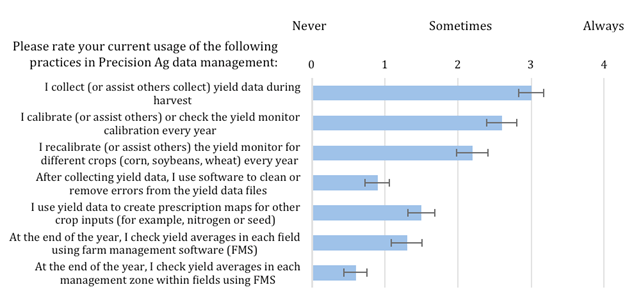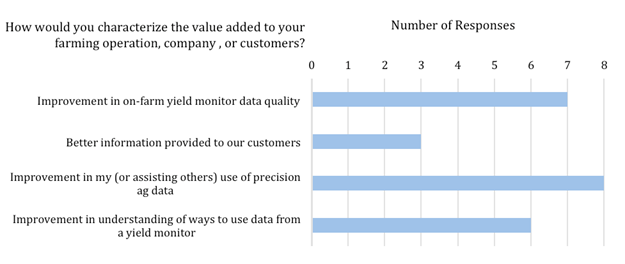 |
August 2015
|
August 2015 // Volume 53 // Number 4 // Tools of the Trade // v53-4tt10
Hands-On Precision Agriculture Data Management Workshops for Producers and Industry Professionals: Development and Assessment
Abstract
Three Precision Agriculture Data Management workshops regarding yield monitor data were conducted in 2014, reaching 62 participants. Post-workshop surveys (n=58) indicated 73% of respondents experienced a moderate to significant increase in knowledge related to yield monitor data usage. Another 72% reported that they planned to utilize best management practices presented or would expand their current practices based on knowledge gained. One-year post-workshop survey (n=14) results indicated that far less (36%) were able to implement some of the techniques presented. However, comments indicated that accessible follow-up material would be beneficial in successfully integrating learning topics into data management systems.
Introduction and Objectives
Since the introduction of precision agriculture technologies, a constant struggle among practitioners (e.g., producers, retailers, and consultants) has been how to successfully collect, analyze, and interpret the many data types available. Attempts by university Extension personnel to address this issue via hands-on workshops have been documented (Griffin & Lambert, 2005), specifically related to yield monitor data interpretation. Since then, industry personnel have taken precision agriculture data management on as part of their product offerings in the commercial production system. However, Griffin, Dobbins, Florax, Lowenberg-DeBoer, and Vyn (2010) suggested that university Extension should still play a role in addressing additional knowledge gaps, specifically related to conducting and analyzing on farm research data. Training or information material delivery may take many forms; however, Wortmann, Glewen, and Williams (2011) recently noted that hands-on activities were often viewed as the most effective method for facilitating adoption by practitioners.
Precision Agriculture Data Management workshops were developed by Nebraska Extension. Three, day-long workshops were held in Nebraska between January and March 2014. The workshops were attended by producers, crop consultants, and agricultural product retailers. The main goal was to provide attendees with the skills necessary to collect and use yield monitor data to improve efficiency in their operations. Specific objectives were to provide training on 1) methods to collect more accurate yield monitor data and 2) data analysis techniques to improve decision-making for crop production operations. Ancillary objectives were to interpret survey information to assess participant satisfaction, learning, and application of workshop topics.
Materials and Methods
Two software programs (Ag Leader SMS v 14.2 and Yield Editor v 2.0) were loaded onto laptop computers for use by workshop attendees. Yield monitor data from field harvest operations was loaded into the SMS software. The workshops were conducted using three methods to communicate information to attendees: Microsoft PowerPoint lectures were combined with instructor-guided and self-guided (printed tutorials) hands-on software training using both the SMS and Yield Editor programs.
Specific skills that were developed using the software and data included:
- Techniques to minimize errors during harvest data collection,
- Methods for removing errors from yield monitor data through post-processing,
- Procedures for quantifying crop productivity within field management zones.
Pre-workshop surveys attempted to gauge current practices related to topics presented. Post-workshop surveys focused on two areas: 1) assessing the knowledge gained from the materials presented and 2) determining the likelihood for adoption of workshop practices and techniques. Pre- and post-workshop survey questions used a 0-4 scale, with 0 being low knowledge/low skill level and 4 being high knowledge/high skill level.
A 1-year online follow-up survey sought to gauge whether workshop topics had been attempted or adopted by attendees. The survey consisted of nine rating-scale and open-ended questions and was presented via email to 47 attendees.
Results and Discussion
Pre- and post-workshop surveys were completed by 58 attendees (94%) among the three workshops. Pre-workshop surveys indicated that, while many respondents were collecting yield data, far fewer were using more complex processing or analysis techniques.
- 71% responded they almost always use yield data collection practices on a yearly basis.
- 55% indicated they almost always continually use proper recalibration techniques on a yearly basis for improving their yield data accuracy.
- 12% responded they almost always use some form of software to remove errors from yield data through post-processing.
- 10% to 33% responded they currently almost always use spatial yield data in any further analysis to evaluate their production practices.
Figure 1 illustrates the average response to each pre-workshop question with standard error (standard deviation divided by square root of the n). It is often challenging to determine exactly what level of proficiency many agricultural data users possess. Analyzing feedback of this nature provided an indication that many of the attendees were likely ready to progress from data collection to more complex analyses.
Figure 1.
Pre-Workshop Survey Analysis Results for Benchmarking Current Usage of Precision Agriculture Data Management Techniques (n=58); Standard Error Bars Included.
Post-workshop surveys indicated that the majority of respondents learned new techniques during the workshop and would likely incorporate those practices to enhance data accuracy and usefulness.
- 73% (n=42) felt as though they had achieved moderate to significant (>3 on a scale of 0 to 4) gains in knowledge regarding workshops topics.
- 72% (n=41) thought that they would either start implementing many of the BMPs presented or expand their current practices.
Based on this post-session feedback, the workshops were generally believed to be both informative and motivational.
Fourteen online survey responses (30% of the 47 attendees emailed) were logged, which consisted of six producers/landowners, seven private industry consultants/retailers, and one educator.
Regarding yield monitor data collection and usage:
- 100% (n=14) indicated that the workshop improved their ability (or ability to assist others) to collect and use yield monitor data.
- 36% (n=5) indicated that they had been able to implement post-processing techniques or BMPs to improve their yield data. This is slightly lower than the 72% indicating that they felt they could accomplish this in the post-workshop survey.
- Of the 65% who had not yet been able to implement BMPs, the majority indicated that they would need more time and information to do this.
Regarding yield data quantification within management zones:
- 71% (n=10) indicated that the workshop did improve their ability to quantify yield data within management zones;
- Of the remaining 29% (n=4) who did not feel they learned much from this portion of the workshop, three indicated the need for more time or information and one indicated that there was no desire to perform this type of analysis.
Regarding overall feelings about the workshop after 1 year:
- 79% (n=11) felt that the workshops added value to operation, company, or customers;
- Of those eleven noting added value, 64% (n=7) indicated improved yield data quality and usage, while 73% (n=8) indicated improved outlook for using precision agriculture data (Figure 2).
Figure 2.
Responses of Value Added to Operations (of those (n=11) Indicating Value Was Added) from 1-Year Follow-Up Survey Analysis Results (n=14)

Conclusions
While the post-workshop survey results indicated that most attendees did feel an improvement in both knowledge and optimism about using new skills, the 1-year follow up survey showed that many of those were not successful in implementing this new knowledge. Although the 1-year survey was only completed by 20% of those originally attending the workshops, 35% indicated that they were able to implement post-processing BMPs, compared to 72% at the conclusion of the workshops. Based on feedback a year later, new procedures may help many to actually use the processes and techniques presented. Providing attendees with datasets to practice with, or making these data available online with tutorials may be more effective towards long-term adoption. In the end, optimism towards this Extension activity appeared to be well-received, even 1 year after the workshops concluded, and attendees indicated an appreciation for the material presented and the hands-on nature of the learning environment.
References
Griffin, T. W., Dobbins, C. L., Florax, R. J. G. M., Lowenberg-DeBoer, J. M., & Vyn, T. J. (2010). Spatial analysis of precision agriculture data: role for extension. Journal of the NACAA, 3(1) Retrieved from: http://www.nacaa.com/journal/index.php?jid=40
Griffin, T. W., & Lambert, D. (2005). Teaching interpretation of yield monitor data analysis: lessons learned from Purdue's 37th Top Farmer Crop Workshop. Journal of Extension [On-line], 43(3) Article 3IAW5. Available at: http://www.joe.org/joe/2005june/iw5.php
Wortmann, C. S., Glewen, K. L., & Williams, S. N. (2011). Impact of crop management diagnostic clinics on advisors' recommendations and producer practices. Journal of Extension [On-line], 49(4) Article 4FEA8. Available at: http://www.joe.org/joe/2011august/a8.php



